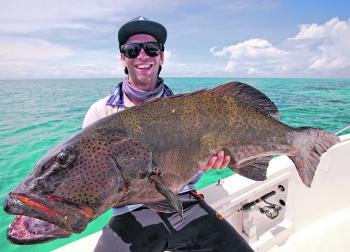The key to fishing in the peak of the wet season is be prepared to take advantage of any spell of good weather. They can be few and far between some years and other years they are bountiful. Irrespective, grab them when they arise.
The reef has been fishing quite well for this time of year, though there have been reports of large numbers of under sized coral trout, mixed with a few good fish. Generally speaking, if the sea surface temperature is over 30°C, concentrate your efforts in the 40m+ depths. There will be the odd occasion when fish will move up to shallow waters at higher water temperatures. Largemouth nannygai will mostly be in the ideal eating range of 3-4kg, with the odd trophy fish thrown in for bragging rights. Other than these two species, most catches will be a pretty mixed bag, with the odd red emperor, reef red bream, Moses perch, spangled emperor, long-nosed emperor, stripy and cod thrown in.
Spanish mackerel will still be around in small numbers, along with plenty of trevally. Trolling live baits, swimming baits and lures covering a variety of depths will see you with a good chance of bringing home the odd quality eating Spaniard in the 6-10kg range.
With the weather so unpredictable in March, most anglers will hang closer to shore. The inshore islands, reefs, wrecks and rocks are all worth a look for golden snapper, large mouth nannygai, cobia, Spanish and doggy mackerel. Live baits are by far the most productive but soft plastics, soft vibes and metal jigs will all work to produce the goods. If there is a good show of fish and/or bait on the sounder, jigging is often the best way to start the session. If things look pretty quiet on the sounder then live baiting is the way to go.
Prawns should be on the move in the estuaries and along the beaches and with them will come a wide array of predators. Salmon, both king and blue, should be around the northern beaches, especially if there are schools of mullet around as well. The flats out in front of the Cairns esplanade will be well worth a look for grunter, especially on the monster morning high tides and in the lead up to the full moon. The big morning high tides on the lead up to the new moon, will be another great time to work the flats in search of grunter. The last half of the run-in and the first of the falling tide is the best time, with peeled prawns and strip baits of mullet, sardines, mud herring, gar, squid or cuttlefish all productive at times. Small live baits of prawns, sardines, mud herring and mullet will often account for the larger grunter. Another productive big grunter bait is butterflied sardines or mud herring. Fillet the bait from the tail to the head on one side and remove the knife. Fold the fillet forward over the head and thread the bait on a long shank 2/0 or 3/0 hook from the tail to the head. The last time through with the hook should pin the fillet lying forward over the head of the bait. Very small mullet, under 10cms, also work well presented this way.
Barra will be the main target for the lure tossers, with the afternoon low tide, around the full and new moons, the best times to chase them (unless there has been a lot of rain). If the streams are running red, focus your efforts around the small gutters, drains and creeks where they flow into the main stream. Another good place to concentrate on, is anywhere the water-flow is impeded by structure. Below any drain, small bridge, weir or road culvert are spots where barra will sit in ambush and are ideal places to focus your casting as floodwaters recede.
Mangrove jack will also be on the prowl and are often found in the same location as barra, although they don’t tend to congregate at small freshwater outlets as much as barra. Jacks prefer heavier cover so tidal drain mouths with plenty of rock or snags are a more productive location.
Freshwater streams are a good place to fish as you walk the banks in the shade of the rainforest on a hot afternoon. They are particularly productive as the water starts to clear after heavy rain. Please be careful, as estuarine crocs have been pushing further upstream in recent years. Jungle perch, sooty grunter, barra and mangrove jack can all be encountered in these locations.
Golden snapper should be prowling the headlands, inshore reefs and islands. Live prawns, sardines, mud herring and mullet fished on a dropper rig, is a highly successful technique. Trolling lures that can get to the bottom are also productive at times, along with jigging jerk shads and soft vibes. Paddle-tail soft plastics also work well in shallower water. The key is to work around heavy structure and keep the lure close to the structure for as long as possible.
Don’t forget the crab pots when there is plenty of fresh in the tidal streams. It will get the crabs moving and there is nothing like a feed of crab sandwiches, with salt, pepper and avocado for lunch.
Reads: 1191
When the good trout come along they can be absolute monsters, like these stonkers caught and released by Tom Smith.

There will be the odd trophy largemouth nannygai thrown in for bragging rights, like this brace caught by Beau Lockhard off Cairns.




